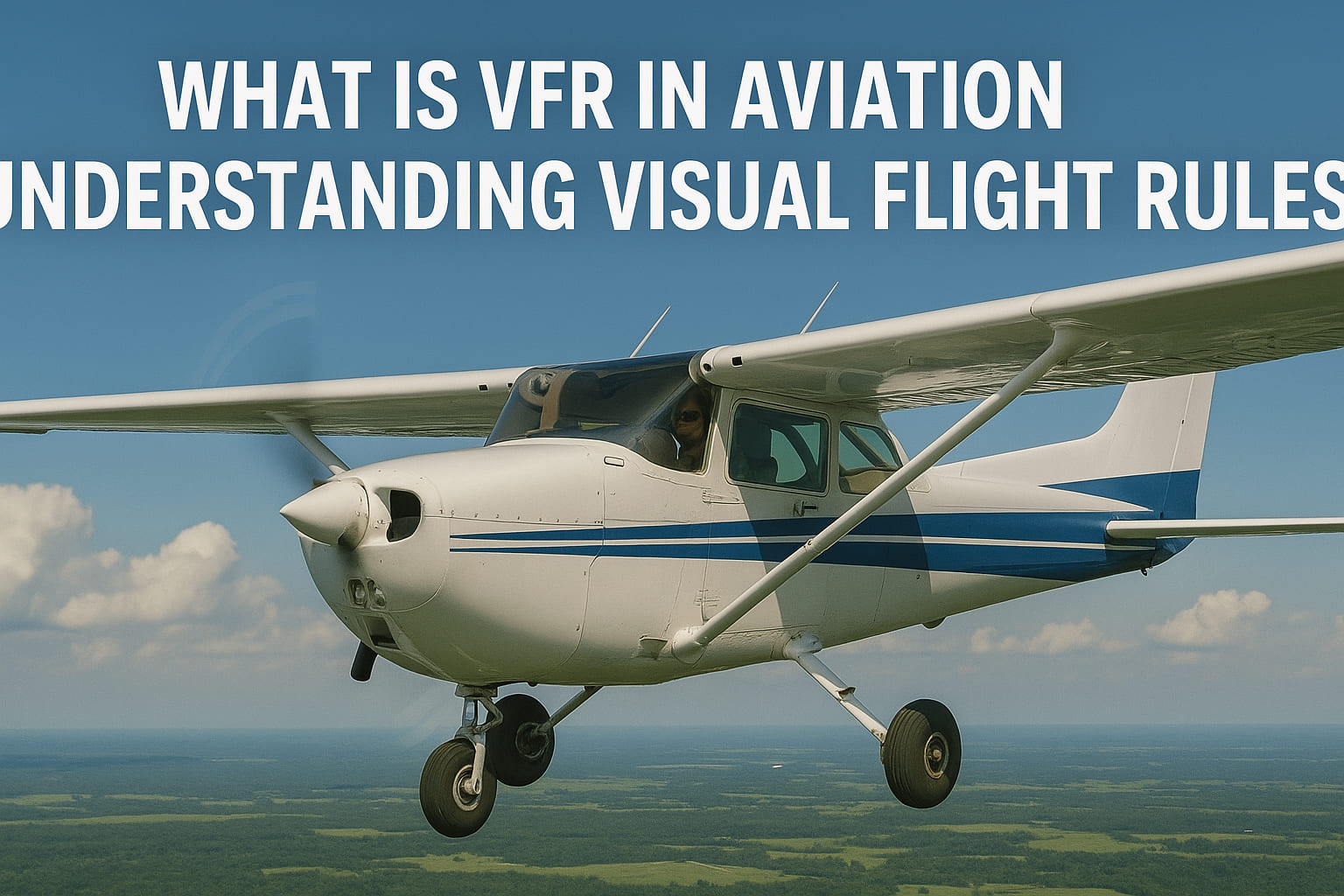Flying on a clear day is based on the simple principle of “see and avoid,” the foundation of Visual Flight Rules. But what is VFR in aviation beyond just looking out the window? It’s a strict framework dictating weather minimums, cruising altitudes, and pilot responsibilities that ensure safety. This guide breaks down how these rules work.
👉 Check out the offer: jet engine stands lease 👈
What Are Visual Flight Rules (VFR)?
Visual Flight Rules (VFR) are a set of regulations governing flight in weather clear enough for the pilot to navigate by sight. This framework is built on the “see and avoid” principle, which makes the pilot directly responsible for navigating by visual landmarks, maintaining separation from other aircraft, and avoiding obstacles.
VFR is not just a flying technique but a formal regulatory framework. Aviation authorities establish specific weather minimums—such as required visibility and distance from clouds—that pilots must meet. If conditions fall below these thresholds, pilots are required to operate under a different set of regulations: Instrument Flight Rules (IFR).
VFR Minimums — Weather Requirements
To fly under VFR, weather conditions must meet specific criteria known as VFR minimums. These legal thresholds for visibility and cloud clearance ensure it’s safe for a pilot to navigate visually. Weather that meets or exceeds these minimums is defined as Visual Meteorological Conditions (VMC)—essentially the “green light” for VFR flight, confirming a pilot can reliably see other aircraft, terrain, and obstacles.
VFR minimums are built on two main components:
- Flight Visibility: The average forward distance from the cockpit that a pilot can see and identify prominent objects.
- Distance from Clouds: The buffer zone that must be maintained around clouds—vertically and horizontally—to provide reaction time in case another aircraft emerges.
These requirements vary by airspace class and altitude. For example, a common standard below 10,000 feet is the “3-152” rule:
- 3 statute miles of visibility
- 1,000 feet above clouds
- 500 feet below clouds
- 2,000 feet horizontally from clouds
Above 10,000 feet, visibility requirements often increase to 5 statute miles because aircraft are typically flying faster.
The pilot in command holds the final responsibility for confirming that weather conditions meet VFR minimums before takeoff and throughout the flight. This requires analyzing weather reports, studying forecasts, and making real-time assessments from the cockpit. If conditions deteriorate below VMC, the pilot must respond by altering the route, landing at a suitable airport, or transitioning to IFR if qualified and equipped.
VFR vs IFR — Key Differences
Flights operate under either Visual Flight Rules (VFR) or Instrument Flight Rules (IFR), distinguished primarily by how pilots navigate and maintain separation. The choice is dictated by weather conditions, aircraft equipment, and pilot qualifications.
| Feature | VFR (Visual Flight Rules) | IFR (Instrument Flight Rules) |
|---|---|---|
| Navigation | By visual reference to the ground | By aircraft instruments and ATC guidance |
| Separation | Pilot’s responsibility (“see and avoid”) | Provided by Air Traffic Control (ATC) |
| Weather Conditions | Clear weather (VMC) only | Can operate in poor visibility (IMC) |
| Pilot Requirements | Private Pilot Certificate | Additional Instrument Rating required |
| Flight Planning | Flexible, not always required | Strict, pre-filed flight plan required |
Pilot Certification for VFR Operations
Operating an aircraft under Visual Flight Rules requires specific training and certification. The first step is earning a Private Pilot Certificate, the primary credential confirming a pilot has the essential knowledge and skills for safe flight in clear weather.
Training for this certificate is comprehensive, focusing heavily on the core demands of visual flying. Student pilots learn to navigate by referencing ground landmarks, interpret weather reports to confirm VFR minimums, and handle emergencies without relying on advanced instrumentation. It is this practical knowledge that equips a pilot to make sound, safe decisions based on visual information alone.
Beyond theoretical knowledge, proficiency is demonstrated through hands-on skill. A VFR pilot must be adept at maintaining aircraft control by referencing the horizon and other external visual cues. Mastering visual separation—the pilot’s primary duty to spot and avoid other aircraft—is central to this. Adhering to VFR weather minimums is therefore not just a regulatory requirement; it’s a critical safety discipline instilled in every student.
While a Private Pilot Certificate covers basic VFR operations, certain conditions require extra qualifications, such as:
- Night Flying: Requires specific training and an endorsement, as navigation is more challenging without daylight.
- Complex Airspace: Operating within some of the busiest controlled airspace may require additional endorsements to ensure the pilot is prepared for a high-traffic environment.
Earning the certificate is only the first step; continuous experience is essential to maintain the sharp situational awareness that safe VFR flight demands.
VFR Cruising Altitude Rules
While the “see and avoid” principle is a VFR pilot’s primary tool for collision avoidance, it is reinforced by a standardized system of vertical separation. To prevent the chaos and risk of aircraft flying at random altitudes, aviation regulations establish specific VFR cruising altitude rules. These mandatory guidelines apply to flights operating more than 3,000 feet above the ground (AGL) and are determined by the aircraft’s magnetic course.
- Eastbound (0° to 179°): Fly at an odd thousand-foot altitude plus 500 feet (e.g., 3,500, 5,500 ft).
- Westbound (180° to 359°): Fly at an even thousand-foot altitude plus 500 feet (e.g., 4,500, 6,500 ft).
A common mnemonic is: “East is Odd, West is Even (odder).”
This “plus 500 feet” component is a critical safety feature. Since aircraft on Instrument Flight Rules (IFR) typically cruise at whole thousand-foot altitudes (e.g., 4,000 or 5,000 feet), offsetting VFR traffic creates a built-in vertical buffer. This simple but effective rule drastically reduces the risk of midair conflicts and helps establish a predictable, organized flow of traffic, making the skies safer for everyone.
Special VFR Operations — What You Need to Know
When weather conditions dip just below standard VFR minimums but are not poor enough to require a full instrument flight, a pilot can request Special VFR (SFR). This is a specific clearance from Air Traffic Control (ATC) that permits operation within controlled airspace when visibility or cloud clearance is substandard, allowing a pilot to safely complete a flight—for instance, landing at an airport when a localized fog bank rolls in.
To receive an SVFR clearance, a pilot must maintain at least 1 statute mile of flight visibility and remain clear of clouds. This clearance is only applicable within the surface areas of Class B, C, D, or E airspace near an airport and is designed for local operations, not for cross-country travel in marginal weather.
An SVFR clearance is not automatic; the pilot must explicitly request it from ATC. For example, a pilot might say, “Tower, November-One-Two-Three-Alpha-Bravo is ten miles north, requesting Special VFR for landing.” ATC will only grant the request if IFR traffic permits, to maintain proper separation. A crucial limitation is that night SVFR operations are only permitted if the pilot holds an instrument rating and the aircraft is equipped for IFR flight.
While SVFR is a useful tool in marginal conditions, it places significant responsibility on the pilot. The “see and avoid” principle remains the primary rule, even with just one mile of visibility. This clearance is designed for navigating specific, short-term weather challenges—not as a workaround for lacking an instrument rating. Its safe use demands sharp situational awareness and sound judgment.
Controlled VFR — Guidelines and Regulations
Whereas Special VFR handles weather exceptions, Controlled VFR (CFR) is designed for the challenges of busy, complex airspace. Under CVFR, a pilot flies by visual rules but receives direct instructions from Air Traffic Control (ATC), such as specific headings and altitudes. This creates a hybrid environment that mirrors the structure of IFR, yet without requiring the pilot to hold an instrument rating or fly an IFR-equipped aircraft.
The primary purpose of CVFR is to improve safety and efficiency in high-density traffic areas, a system notably used in places like Canadian Class B airspace where ATC oversight is mandatory. By providing positive control, ATC ensures safe separation and proactively resolves potential conflicts while the pilot continues to navigate visually. This system merges the pilot’s real-time situational awareness with the structured guidance of air traffic controllers.
Crucially, CVFR is a specific designation used in countries like Canada and is not a formal term in the United States. While a VFR pilot in U.S. Class B or C airspace also communicates with ATC and follows instructions, this is simply considered a standard VFR operation. The outcome is similar—a VFR flight under ATC guidance—but the terminology and regulatory framework differ.
Controlled VFR provides an organized framework for managing visual traffic in congested skies. The pilot remains responsible for the core ‘see and avoid’ principle but benefits from the added safety of ATC’s separation services. The result is a smoother traffic flow and a reduced risk of midair collisions in areas where visual navigation alone cannot safely manage the volume of aircraft.
Conclusion — The Importance of VFR in Aviation
Visual Flight Rules are more than just regulations; they represent the essence of flying. VFR is built on a pilot’s ability to see the world—the horizon, landmarks, and other aircraft—and use that visual information to navigate safely. As the foundation of pilot training, it is grounded in the core ‘see and avoid’ principle.
While flying in clear weather may seem simple, VFR operations demand significant discipline. Pilots must master protocols ranging from weather minimums and cloud clearance to cruising altitude rules. While this framework provides order, the ultimate responsibility for situational awareness and collision avoidance remains with the pilot, requiring constant vigilance.
From a student pilot’s first solo flight to an experienced aviator navigating a busy terminal area, VFR is the fundamental skill for safe operations. Its principles are adaptable, allowing for Special VFR in marginal conditions and integrating with air traffic control for added safety in congested airspace. It stands as the essential counterpart to IFR, providing the flexibility to operate when the weather is clear and the view is unobstructed.
Even with advanced avionics and automation, the ability to look out the window, interpret the visual landscape, and safely guide an aircraft remains the most critical skill a pilot can possess. VFR is not just a method for flying—it is the fundamental connection between the pilot, the aircraft, and the sky.

